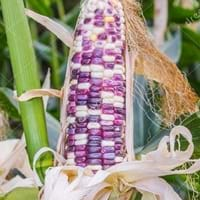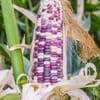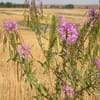Life Span
Perennial
Perennial
Origin
Hybrid origin, North America, Southeastern United States, Central America, South America
Southern Europe
Types
Field Corn, Sweet Corn, Baby Corn, Indian Corn
Bigleaf hydrangea, Hortensia, Smooth hydrangea, Oakleaf hydrangea, Annabelle
Number of Varieties
Not Available
Habitat
Clay soil areas, Loamy soils, Sandy areas
Forest edges, Hillside, Woods
USDA Hardiness Zone
Not Available
5-9
AHS Heat Zone
12-4
Not Available
Sunset Zone
A1, A2, A3, H1, H2, 1a, 1b, 2a, 2b, 3a, 3b, 4, 5, 6, 7, 8, 9, 10, 11, 12, 13, 14, 15, 16, 17, 18, 19, 20, 21, 22, 23, 24
21,22
Habit
Upright/Erect
Clump-Forming
Flower Color
Not Available
Yellow green
Flower Color Modifier
Bicolor
Bicolor
Fruit Color
White, Yellow, Light Yellow, Peach, Burgundy, Dark Red, Dark Blue
Sandy Brown
Leaf Color in Spring
Green, Dark Green
Green
Leaf Color in Summer
Green, Dark Green
Green
Leaf Color in Fall
Green, Dark Green
Green
Leaf Color in Winter
Green, Dark Green
Light Green
Leaf Shape
Long Linear
Oblovate
Plant Season
Spring, Summer, Fall
Spring, Summer, Fall
Sunlight
Full Sun
Full Sun, Partial Sun
Growth Rate
Very Fast
Fast
Type of Soil
Loam
Loam, Sand
The pH of Soil
Neutral
Neutral
Soil Drainage
Well drained
Well drained
Bloom Time
Indeterminate
Early Summer, Summer, Late Summer
Tolerances
Drought
Drought
Where to Plant?
Ground
Container, Ground
How to Plant?
Seedlings
Seedlings, Stem Planting
Plant Maintenance
Medium
Medium
Watering Requirements
Average Water Needs, Do Not over Water, Needs watering once a week, Never Over-water, Over-head watering
Not Available
In Summer
Lots of watering
Average Water
In Spring
Moderate
Moderate
In Winter
Average Water
Average Water
Soil Type
Loam
Loam, Sand
Soil Drainage Capacity
Well drained
Well drained
Sun Exposure
Full Sun
Full Sun, Partial Sun
Pruning
Remove damaged leaves, Remove dead branches, Remove dead leaves
Remove damaged leaves, Remove dead branches, Remove dead leaves
Fertilizers
All-Purpose Liquid Fertilizer
All-Purpose Liquid Fertilizer
Pests and Diseases
Red blotch
Red blotch
Plant Tolerance
Drought
Drought
Flowers
Insignificant
Showy
Flower Petal Number
Not Available
Single
Fragrant Bark/Stem
No
Yes
Foliage Texture
Coarse
Medium
Foliage Sheen
Glossy
Glossy
Evergreen
No
Semi-Evergreen
Attracts
Not Available
Butterflies
Allergy
Asthma, Diarrhea, Headache, Nausea, Runny nose, Skin rash, sneezing, Vomiting
Chest tightness, Diarrhea, Dizziness, Nausea, Vomiting
Aesthetic Uses
Not Used For Aesthetic Purpose
Not Available
Beauty Benefits
Not Available
Not Available
Edible Uses
Yes
Not Available
Environmental Uses
Air purification
Air purification
Medicinal Uses
Anemia, Antioxidants, Diabetes, Improve heart health, Indigestion, Nutrients
Fever, Kidney problems, Urinary tract problems
Part of Plant Used
Fruits
Flowers, Root
Other Uses
Economic Purpose, Employed in herbal medicine, Oil is used as an industrial solvent, Used As Food, Used for its medicinal properties
Not Available
Used As Indoor Plant
No
Not Available
Used As Outdoor Plant
Yes
Yes
Garden Design
Edible, Herb, Vegetable
Edible, Herb / Vegetable
Botanical Name
ZEA mays 'Cutie Pops'
PETROSELINUM crispum var. tuberosum 'Bartowich Long'
Common Name
Indian Corn
Root Parsley
In Hindi
इंडियन मकई
Hydrangea
In German
Mahiz
Hortensie
In Spanish
Maíz indio
Hortensia
In Greek
Αραβόσιτος
υδραγεία
In Portuguese
milho
Hortênsia
In Polish
Indian Corn
Hortensja
In Latin
Latin Re frumentaria
Hibiscus
Phylum
Streptophyta
Not Available
Class
Liliopsida
Not Available
Order
Poales
Not Available
Clade
Angiosperms, Commelinids, Monocots
Not Available
Tribe
Andropogoneae
Not Available
Subfamily
Panicoideae
Not Available
Number of Species
Not Available
Not Available
Importance of Indian Corn and Root Parsley
Want to have the most appropriate plant for your garden? You might want to know the importance of Indian Corn and Root Parsley. Basically, these two plants vary in many aspects. Compare Indian Corn and Root Parsley as they differ in many characteristics such as their life, care, benefits, facts, etc. Every gardener must at least have the slightest clue about the plants he wants to plant in his garden. Compare their benefits, which differ in many ways like facts and uses. The medicinal use of Indian Corn is Anemia, Antioxidants, Diabetes, Improve heart health, Indigestion and Nutrients whereas of Root Parsley is Fever, Kidney problems and Urinary tract problems. Indian Corn has beauty benefits as follows: Not Available while Root Parsley has beauty benefits as follows: Not Available.
Compare Facts of Indian Corn vs Root Parsley
How to choose the best garden plant for your garden depending upon its facts? Here garden plant comparison will help you to solve this query. Compare the facts of Indian Corn vs Root Parsley and know which one to choose. As garden plants have benefits and other uses, allergy is also a major drawback of plants for some people. Allergic reactions of Indian Corn are Asthma, Diarrhea, Headache, Nausea, Runny nose, Skin rash, sneezing and Vomiting whereas of Root Parsley have Chest tightness, Diarrhea, Dizziness, Nausea and Vomiting respectively. Having a fruit bearing plant in your garden can be a plus point of your garden. Indian Corn has showy fruits and Root Parsley has no showy fruits. Also Indian Corn is not flowering and Root Parsley is not flowering . You can compare Indian Corn and Root Parsley facts and facts of other plants too.



